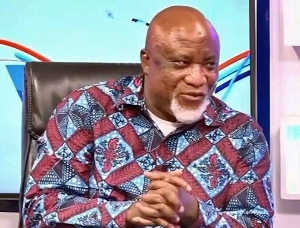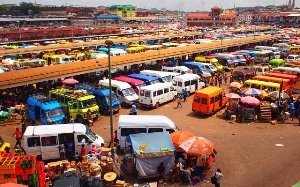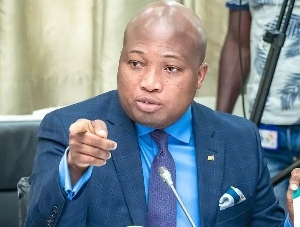 President of IMANI Ghana, Franklin Cudjoe
President of IMANI Ghana, Franklin Cudjoe
Ghana’s new administration will be exactly 54 days old when it presents its maiden budget on March 2, 2017. Below are random questions put together by some staff of IMANI on energy, economy, education, health and infrastructure (railways, roads, aviation, science & technology, water, sanitation and communications). IMANI will present its preliminary assessment of the 2017 budget on March 3, 2017.
Energy
a. As at December 2016, total power sector debt stood at USD2.4bn. Given the current rate of the energy sector levy (Ghp41/liter on petrol/diesel and Ghp37/liter on LPG), and projected consumption of petroleum products in Ghana for 2017 (5,125,694,000liters and 436,102,800 liters respectively for petrol/diesel and LPG), the expected revenue from the energy sector levy per annum is approximately Ghc2.26bn (USD$0.497bn). This means that it will take approximately 5 years to clear power sector debts ALL OTHER THINGS EQUAL. In light of this, what viable fiscal policy is the government going to consider? Reduce the levies or maintain them as it battles public debts and supply of power simultaneously?
b. Erratic power supply has been attributed to the shutdown of power plants. The inability of businesses to pay the discriminating price of 42cents/kwh; higher than some other jurisdictions across Africa, has largely contributed to the sector’s inability to keep power plants running. As part of the industrialization drive, will the 2017 budget highlight strategies for ensuring transparency in the pricing of power and provide appropriate timelines for implementing these strategies to avoid further burdening of private sector and consequential job losses?
c. Given that production will not expand drastically beyond 120,000bopd in 2017, with prices remaining sticky and oscillating the US$55 mark, how will the 2017 budget secure the possible declining revenues from petroleum whiles guaranteeing further exploration and production?
d. Current Petroleum production will only sustain for 25-30 years. If no new discoveries are made, the economy will suffer the effect of declining revenues from oil given its increasing dependence on revenues from the sector (Share of petroleum revenue in Ghana’s domestic revenue increased from 5.9% in 2011 to 13.5% in 2014). Meanwhile, there are several companies holding exploration licenses but failing to meet their minimum work obligation. What are government’s strategies to incentivize further exploration and production and to fast track the passage of requisite regulations accompanying the petroleum exploration and production bill?
e. The financial and operational viability of SOE’s, particularly ECG, in the power value chain has been under criticism for a long time. This necessitated the MiDA Compact II which has drawn a roadmap for turning the operational and financial viabilities of the SOE’s around. With current proposition of possible off-load of some of the SOE’s onto the bourse, will the 2017 budget or medium term development framework indicate the projected economic gains from the proposed strategy as against arrangements under MiDA Compact II?
f. The government has proposed enhancement in private sector investments in the renewable sector and the proposed plan of the government to augment renewable generation through dedicated renewable energy for industrial development, distributed solar for government and public buildings, solar parks in the northern territory seems to be intent in the right direction. To increase private sector investment what is government’s time bound road map for achieving this along with investment schedules?
Infrastructure.
a. Railways/ Aviation/ Roads Development
The President in his first State of the Nation Address announced the commencement of the Takoradi to Paga railway construction project this year, which will connect the Eastern and Western corridors. It is expected to open the country and provide access to our landlocked neighbours. The government will require an estimated $3.9 billion investment for such a grand project. However, from 2012 to 2016, the total budget allocation to the Ministry of Transport to execute all its projects in the Aviation, Railways, Maritime and road management sub sectors was only GH¢ 701,988,756 ($175m). In 2015, GH¢41.8 million ($10.5m) was spent on redevelopment and construction of railway lines, railway stations, and the supply of rolling stock.
b. Water, Sanitation & Hygiene. Danger is looming in the Water, sanitation and hygiene (WASH) sector as donor funding to the sector keeps dwindling. The budget of the ministry of water resources, works and housing is heavily donor funded. In the last 4 years, the budget allocation to the Ministry was about 2 billion cedis. Out of this amount, internally generated funds contributed just about 1%. In 2015, the total revised budget for the Ministry Water Resources, Works and Housing (MWRWH) was GH¢329,245,957.00, out of this amount 75.5% was donor funded, Government of Ghana contributed only 3.4%. 21.1% came from Annual Budget Fund Allocation (ABFA) whiles Internal Generated Fund (IGF) was only 1.2%. With the ABFA likely to channelled to fund the blanket free SHS policy this year, what innovative funding sources will be available in the upcoming budget to sustain programs in the WASH sector?
c. In 2015, GH¢183.2 million (US$49.2 million) of ABFA was transferred to the Ghana Infrastructure Investment fund (GIIF) to deal with the huge infrastructure deficit in Ghana.
d. Science Technology & Innovation
Ghana currently invests only between 0.2 and 0.6 per cent of Ghana’s Gross Domestic Product (GDP) in Science and Technology Innovation (STI) as compared to some other African countries such as Malawi, South Africa that invest above 1% of their GDP in STI. The low investment partly explains the poor performance of Ghana’s economy, agriculture and manufacturing industries in the last eight years. In 2016, the ministry of Science, technology and innovation had only GH¢274,215,152 allocated to it, 61% of which was to be funded by the Government and 31% by Internal generated fund. The contribution of STI to Ghana’s GDP is estimated to be less than one percent 1%, below the 2.5% average in Africa. We await the 2017 budget to see how much would be allocated to science, technology and innovation to leverage it for economic growth and transformation
e. Communications
The Ministry of communication’s budget is largely donor funded. In 2014, 86% of the GH¢93,988,899 allocated to the ministry to execute its projects and programmes was donor funded. With the dwindling donor support for our budget, we await alternate funding sources that would be available in the upcoming budget to fulfil the promises of the NPP in mainstreaming ICT into the public sector, registering every Ghanaian citizen, digitizing access to social and public services and investing in growing start-ups.
Economy
a. Did you know that the NDC government pledged in its 2012 manifesto to maintain a GDP growth of at least 8% per annum; maintain a single digit inflation rate; reduce fiscal deficit to 5% of GDP; increase per capita income from about $1600 to $2300 by 2017; and improve the international reserve to four month of import cover; Did you know that except in 2012 when an 8 % GDP growth rate was attained (in fact 9.29%) , Ghana missed subsequent GDP growth targets of 8% and all inflation, deficit, per capita income and international reserve targets? We haven’t seen any growth targets by the NPP in their 2016 manifesto. Will the 2017 budget give us any hints?
b. Did you know Ghana has dropped 13 places in the global competitiveness index over the past 5 years? In the 2016/2017 ranking, Ghana placed 114 out of 138 countries. The decline mirrors deterioration in the productive use of available resources in the country. Are the provisions in the upcoming budget going to improve Ghana’s global competitiveness?
c. Over the past 5 years, revenue collection on average has been about 6% below target. How does the persistent deficits in revenue affect Ghana’s credibility on the global financial market given that about 42% of budget deficit is foreign financed?
d. Do you know that for the year 2014 and 2015, interest payments to GDP ratio was more than 6% while Capex for the same period was below 5.5%? How will the NPP government address debt sustainability in the new budget? Should Ghanaians look forward to increased allocations to Capex in the 2017 budget and in subsequent budgets?
e. Ghana is currently ranked 108 out of 190 countries based on the conduciveness of its business environment. It is of little wonder that FDI has fallen by 52.5% between 2012 and 2015. Can the “one district one factory” and the idea of a private sector led economy be feasible in such an environment? What initiatives will be outlined in the March, 2017 budget to improve the regulatory environment in Ghana?
f.Between 2012 and 2015, Government spent averagely 9% more than budgeted on personal emoluments while Capital expenditure was 9% below target. In the same period, personal emoluments constituted about 8.6% of GDP. What is the public sector’s contribution to GDP? Given that at least 70% of total revenues were spent on their compensation, are Ghanaians getting value for money? Are there measures in the 2017 budget to ensure efficient delivery of public service and value for money?
Education & Health
a. The core element of the NPP’s education programme is “free education for all Ghanaian children up to senior high school. Ghana invested on an average 6% of GDP into education over the last 5 years higher than the Sub Saharan average of 5% of GDP in 2015. Compensation takes up 70% of education budget and the residual 30% percent on assets, goods and services. Given that the success of the free SHS policy depends largely on allocations to Goods and Services and Assets, there is a need for readjustment of the education expenditure. Will change in allocation pattern been seen in the education budget in the 2017?
b. The NPP in its 2016 manifesto indicated that the revenue from oil will be allocated to finance infrastructure projects, health, education and agriculture. Oil revenues made up 0.5% of the education budget over the last 5 years and 99.9% of GOG funds going into compensation. What will be the sustainable funding scheme for the Free SHS policy in light of how unpredictable oil revenues can be?
c. 0.07% of oil revenue through the ABFA has been spent on education financing over the period (2012-2015), mostly on recurrent expenditure such as improving the capacity of teachers across the country, supply of teaching and learning materials to basic and secondary schools, feeding and capitation grant, BECE and SHS subsidy for examinations and scholarships. With the High infrastructure deficit and infrastructure provision heavily dependent on the GETFUND and oil revenue, what will be tradeoff between infrastructure provision and Free SHS implementation in 2017 Budget?
d. In the 2016 manifesto, the NPP government made a number of promises regarding Youth and Sport. Many of these promises involved construction, such as the construction of new stadia in the five regions that don’t currently have any, as well as establishing three sports colleges. The emphasis for achieving these promises has been on private sector participation.
e. The majority of budget allocation, an average of 88.04%, to the Ministry of Youth and Sports from 2012-2016 came from the Government of Ghana (GoG). With the planned private sector participation for financing the stadia projects, what share of budget for these agreements will come from the Government and how will this be reflected in the budget?
f. The government has made the assertion that they would like to ‘revive’ the National Health Insurance Scheme (NHIS). In the 2017 State of the Nations Address, the constant arrears that the NHIS is plagued with were cited as a challenge to providing quality healthcare to Ghanaians and an aspect that the government will take special consideration to fix going forward. In 2016, 30% of the Ministry of Health’s allocated budget of almost GHS 4.9 billion was assigned to be spent on the National Health Insurance Fund. The source of this was a statutory fund, the National Health Insurance Levy (NHIL). Given that the main issue with the NHIS is a financial issue, how will the Government uncover additional funds to rectify the issue? Would this lead to an increase in VAT, which funds the NHIL?












